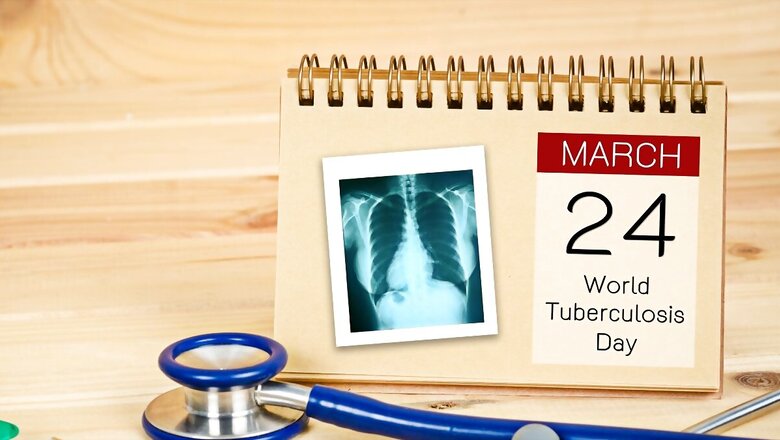
views
Tuberculosis (TB) continues to pose a significant threat as one of the deadliest infectious diseases worldwide, affecting millions of individuals annually. Observed annually on March 24th, World Tuberculosis Day serves as a poignant reminder of the ongoing fight against this illness. Tuberculosis, commonly known as TB, is an infectious disease primarily affecting the lungs and is caused by bacterial infection.
The disease is often spread through the air via airborne particles released during coughing, sneezing, or spitting by infected individuals. Fortunately, TB is both preventable and treatable. It is estimated that approximately a quarter of the global population harbours TB bacteria, with 5–10% of those individuals eventually developing symptoms and progressing to TB disease.
People who carry the bacteria but aren’t yet symptomatic cannot spread the disease. Treatment for TB disease typically involves antibiotics, as it can be fatal if left untreated. Let’s dig deeper into the theme, history, significance, causes, symptoms, and diagnosis of TB on this year’s World Tuberculosis Day.
World TB Day 2024 Theme
The theme of World TB Day 2024 is “Yes! We can end TB!”
“It conveys a message of hope that getting back on track to turn the tide against the TB epidemic is possible through high-level leadership, increased investments and faster uptake of new WHO recommendations,” says the World Health Organization.
Following world leaders’ pledges to accelerate efforts to eradicate TB in 2023, the World Health Organization (WHO) is now prioritizing the transformation of these commitments into tangible actions this year.
World TB Day: History
The history of World TB Day goes back to a long time ago. In 1834, Johann Schonlein first coined the term tuberculosis, though this disease, caused by the Mycobacterium tuberculosis germ, has existed for millions of years, as per the Centers for Disease Control and Prevention.
Throughout history, tuberculosis has been referred to by different names. The Greeks named it phthisis, the Romans tabes, and the Hebrews schachepheth. In the 1700s and 1800s, it was known as the white plague and consumption due to its characteristic of making individuals appear pale and wasted.
On March 24, 1882, Dr. Robert Koch identified Mycobacterium tuberculosis, the bacterium responsible for TB. To commemorate this pivotal discovery, nearly a century later, March 24th was designated as World TB Day. It serves as an opportunity to educate people about the global impact of tuberculosis and how to prevent its spread.
World TB Day: Significance
World TB Day holds immense significance as it raises public awareness about the devastating health, social, and economic repercussions of TB. It serves as a rallying point to intensify efforts towards ending the global TB epidemic.
By educating communities and fostering advocacy, World TB Day plays a crucial role in mobilizing resources and support for TB prevention, diagnosis, and treatment initiatives worldwide.
TB Causes
Tuberculosis is caused by the bacterium Mycobacterium tuberculosis. While the lungs are the most commonly affected organs, TB can also affect other parts of the body such as the kidneys, spine, and brain.
Not everyone infected with TB bacteria develops active TB disease. Instead, two conditions may arise latent TB infection (LTBI) and TB disease. Factors such as weakened immune systems, diabetes, malnutrition and tobacco use can increase the risk of TB disease progression.
TB Symptoms
People with latent TB infection typically do not exhibit symptoms and are not contagious. However, individuals with TB disease may experience a range of symptoms, including prolonged cough (sometimes with blood), chest pain, weakness, fatigue, weight loss, fever, and night sweats. These symptoms can vary depending on the affected organs, as TB can target not only the lungs but also the kidneys, brain, spine and skin.
TB Diagnosis
Early diagnosis is crucial for effective TB management. The World Health Organization (WHO) recommends the use of rapid molecular diagnostic tests, such as the Xpert MTB/RIF Ultra and Truenat assays, as initial diagnostic tools for individuals presenting signs and symptoms of TB. These tests offer high diagnostic accuracy and facilitate the early detection of TB and drug-resistant strains.
Additionally, tuberculin skin tests (TST) or interferon-gamma release assays (IGRA) can help identify individuals with TB infection. However, diagnosing multidrug-resistant TB and HIV-associated TB presents unique challenges, often requiring complex and expensive testing procedures. Children, in particular, pose diagnostic challenges due to the difficulty in detecting TB in this vulnerable population.
World TB Day serves as a critical platform for raising awareness, advocating for action, and mobilising resources to combat tuberculosis globally. Through concerted efforts and collective commitment, the goal of ending TB is within reach. People worldwide can work together to achieve a TB-free future for generations to come.



















Comments
0 comment